Costar User Research
Conducting usability research for CoStar Real Estate Manager platform redesign.
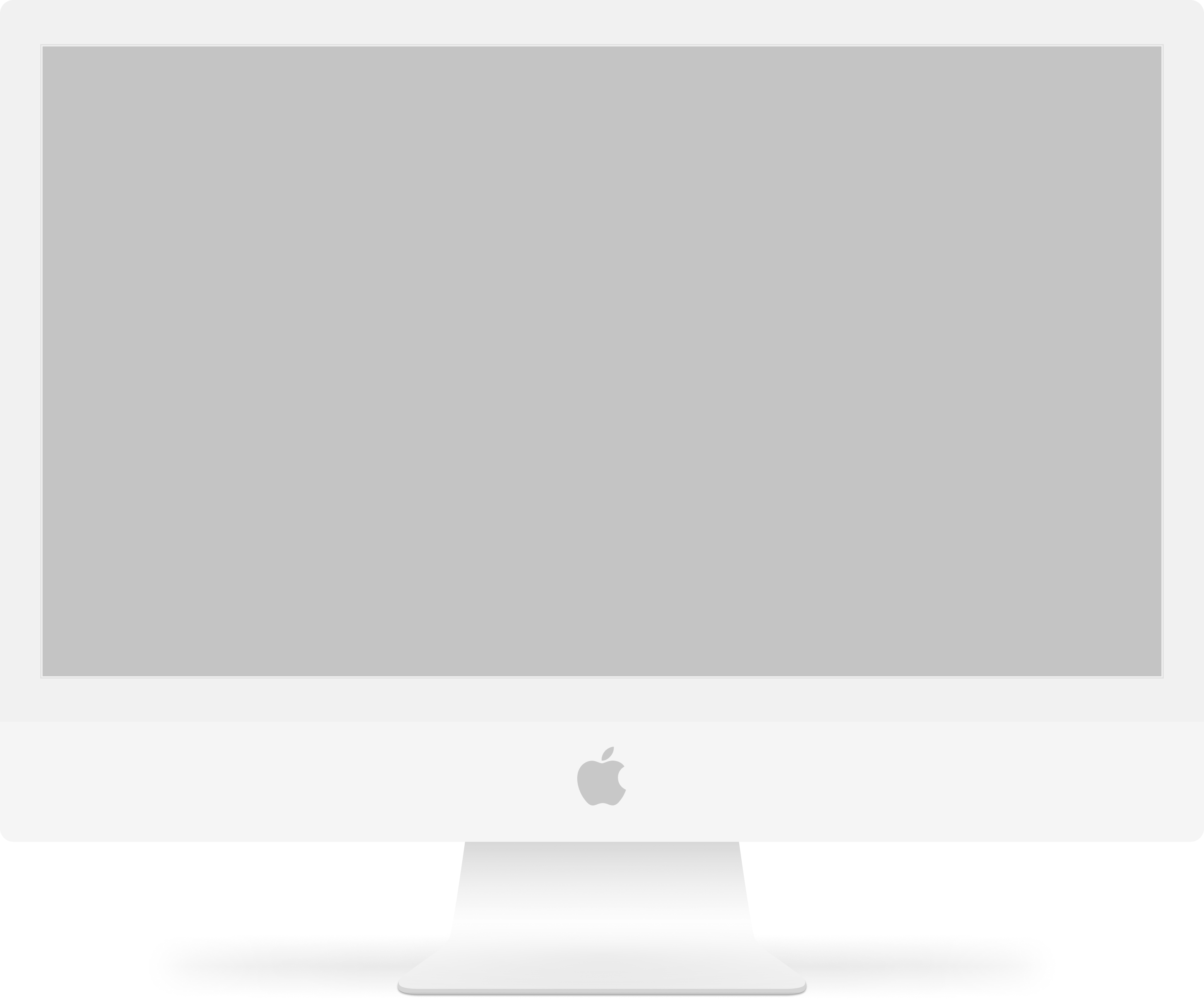
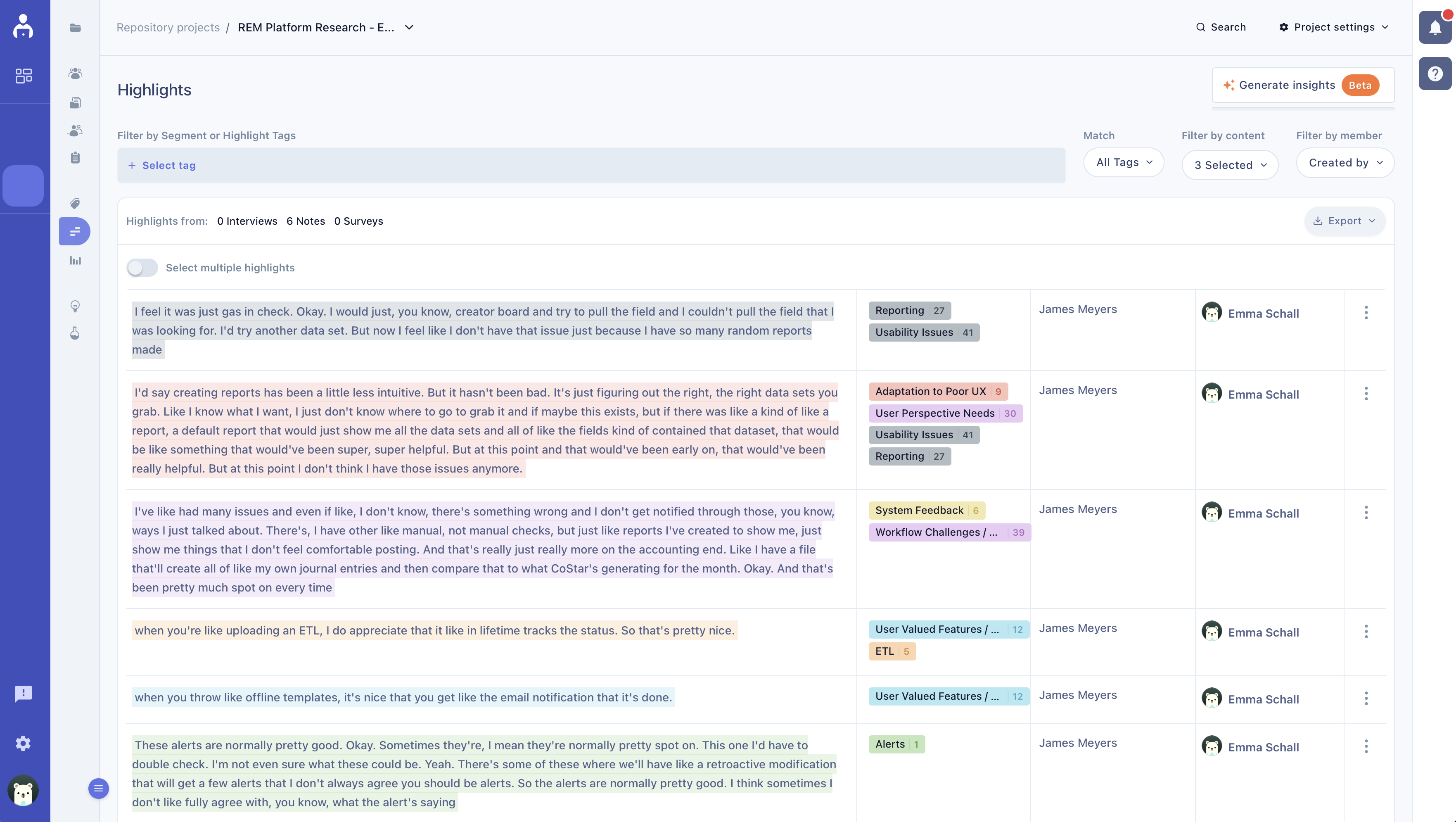
Objective
Understand how users interact with both Visual Lease and Real Estate Manager, and uncover insights that would inform how a future unified platform could best support all user groups.
My Role
Lead Designer
Team
2 Product Designers
Tools
Figma
Figjam
Userbit
Logrocket
Pendo
The Challenge
Real Estate Manager introduced workflows, terminology, and design patterns that differed from those in Visual Lease. The challenge was to align these distinct approaches and underlying business processes in a way that ensured the unified platform could support the diverse needs and expectations of all user groups coming from the legacy systems.
The Solution
Eliminate assumptions by digging deeper, analyzing behaviors, and identifying users’ real needs to uncover authentic insights.
Research & Discovery
Heuristic Evaluation
Before conducting interviews, I reviewed the platform and its workflows to understand the current state, and performed a heuristic evaluation to identify accessibility issues, usability gaps and opportunities to improve consistency, efficiency, and user control.

Key Findings & Focus Areas
Navigation
Users struggle with inconsistent navigation patterns and limited visibility into where they are in the platform. Side navigation changes, unclear breadcrumbs, and inconsistent filtering formats create confusion and extra steps, leaving users uncertain about where to find key pages or results.
Comprehension
The platform’s features and structure are difficult to interpret without prior knowledge. Terminology, filtering logic, and reliance on hidden explanations (e.g., tooltips) make it hard for users to understand available functionality and how to use it effectively.
Execution
Form completion and task execution often feel overwhelming and unclear. A lack of guidance, inconsistent action buttons, poor hierarchy of CTAs, and unclear feedback around errors or saved actions reduce user confidence in whether tasks are being performed correctly.
Stakeholder Interviews
The platform research informed my stakeholder interview questions. I spoke with product leadership, strategy, and customer success teams to understand business goals, constraints, and success metrics, which helped me frame user research findings within the broader business context.
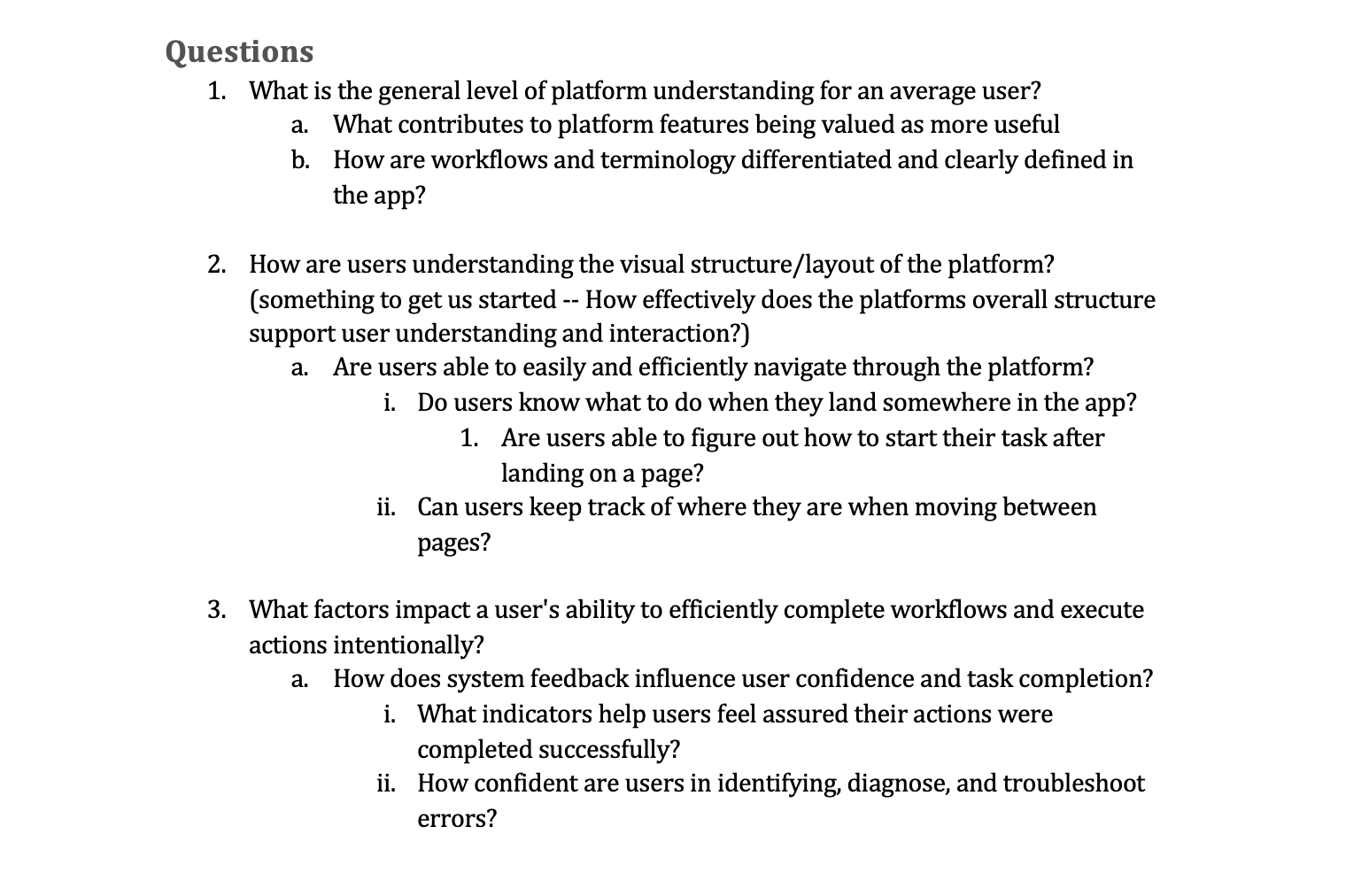
User Interviews
Using data from the heuristic evaluation and stakeholder interviews, I conducted user interviews to map real workflows and confirm key issues. To broaden the perspective, I combined these conversations with user feedback from Pendo and behavior insights from LogRocket session recordings. This mix of qualitative and analytical inputs gave me a clearer picture of user pain points and where the biggest opportunities for improvement were.
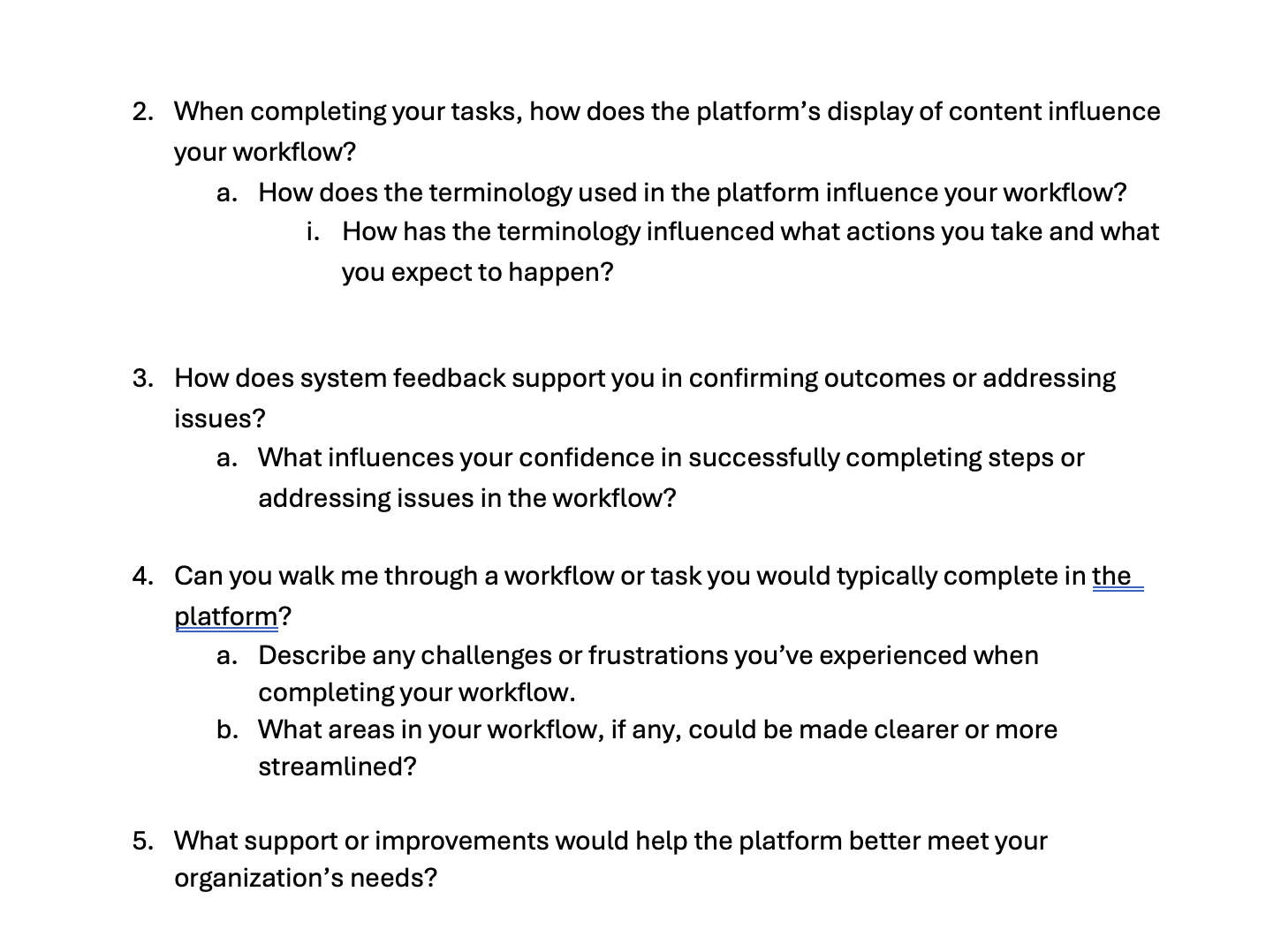
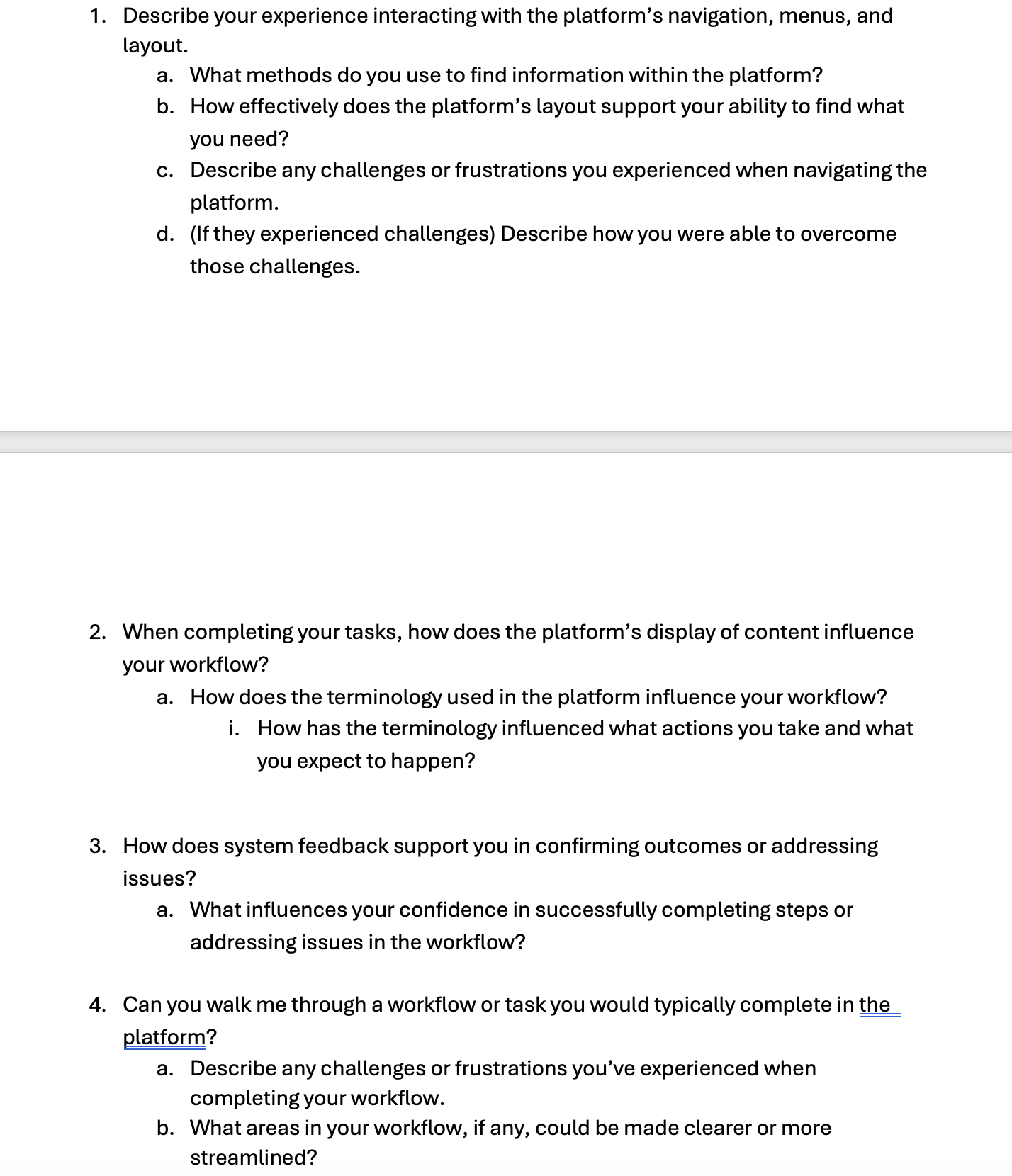
Synthesis
I imported interview recordings into Userbit and reviewed transcripts line by line to tag insights and identify patterns and recurring themes, allowing me to group findings across workflows, features, and user goals. Highlighting representative quotes ensured the insights remained grounded in authentic user experiences.

Analysis
I examined the synthesized insights alongside feedback from Pendo and LogRocket session data to uncover trends, pain points, and opportunities for improvement. This process allowed me to connect user behaviors with business context, revealing actionable recommendations that were both human-centered and data-informed.
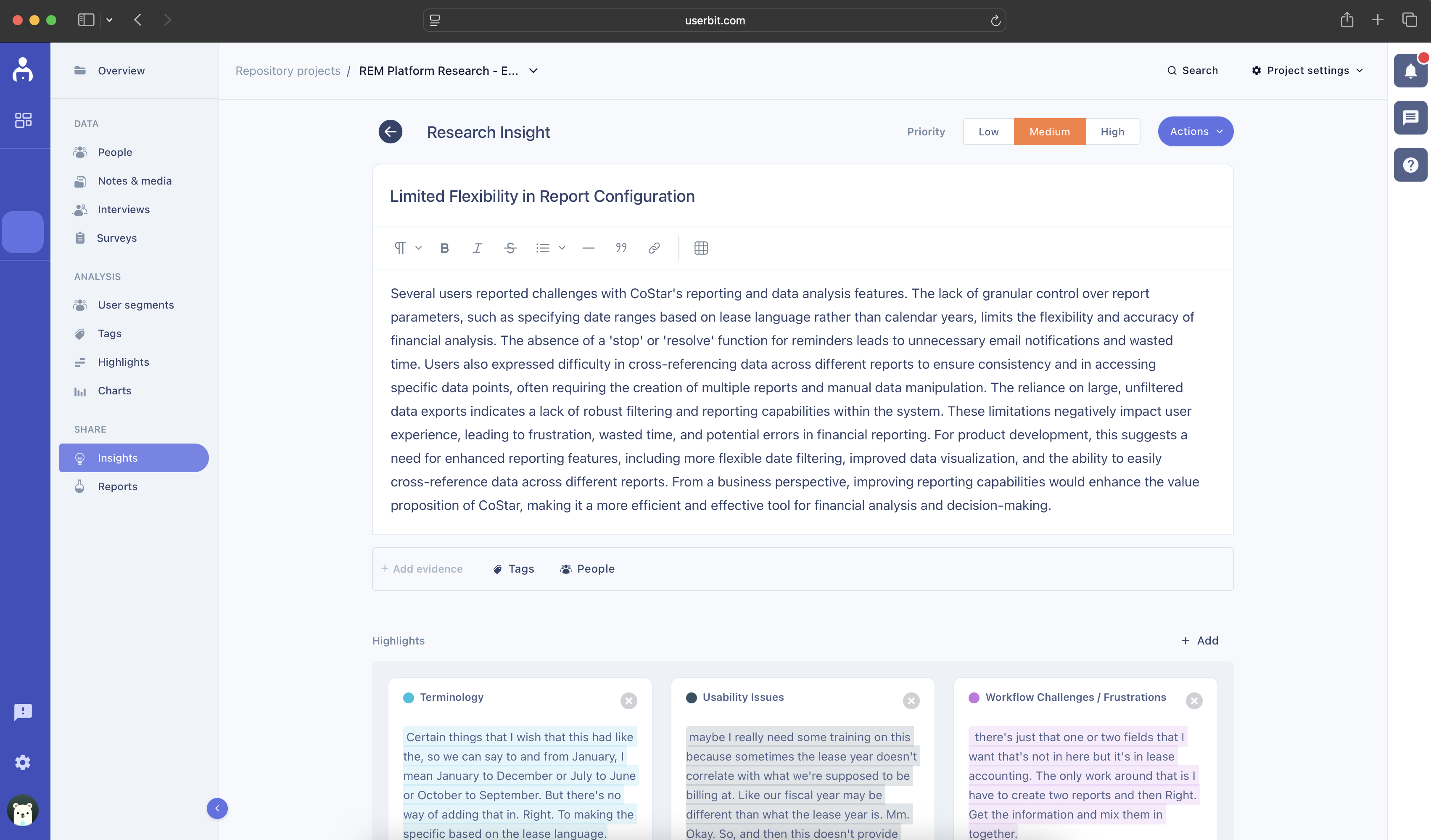
Key Themes & Insights
Limited Reporting Flexibility
Users struggle with rigid report parameters, limited filtering, and the inability to cross-reference or consolidate data efficiently. These gaps force reliance on manual workarounds, increasing errors, wasted time, and frustration.
Inefficient Data Consolidation
The system makes it difficult to combine datasets or generate holistic reports. Users often run multiple reports and manually merge results, which slows workflows and risks inaccuracies.
Insufficient Onboarding
Current onboarding resources don’t adequately equip users to handle complex tasks. The lack of clear, step-by-step guidance creates a steep learning curve, increases support reliance, and slows adoption.
Inadequate Knowledge Base
Users find the knowledge base and training materials too generic and surface-level. Without detailed, contextual support, they struggle to resolve issues independently, leading to frustration and higher support costs.
Takeaways & Impact
Outcomes
Identified Usability Gaps
Surfaced critical issues that directly informed business and design priorities.
Created Team Alignment
Brought cross-functional teams together around shared user pain points.
Translated Feedback into Action
Turned complex user input into clear design requirements.
Influenced Platform Strategy
Positioned UX research as a key input in prioritizing features and shaping platform-level decisions.
Defined Next-Gen Priorities
Delivered evidence-based insights that informed which workflows and capabilities should anchor the next platform roadmap.
Key Learnings
Small Friction, Big Impact
Subtle workflow inefficiencies can cascade into major operational and business consequences if not addressed early.
Listening Beyond Words
High-value insights often emerge from latent user needs and context, requiring advanced probing and synthesis.
Focus on Systemic Patterns
Prioritize recurring behaviors and pain points across user segments to guide strategic product decisions.
Insight Operationalization
Well-structured research outputs and frameworks accelerate cross-functional alignment and translate findings into actionable design strategy.
Empathy as a Strategic Tool
Story-driven insights influence stakeholder decisions, aligning product direction with authentic user needs.
Costar User Research
Conducting usability research for CoStar Real Estate Manager platform redesign.


Objective
Understand how users interact with both Visual Lease and Real Estate Manager, and uncover insights that would inform how a future unified platform could best support all user groups.
My Role
Lead Designer
Team
2 Product Designers
Tools
Figma
Figjam
Userbit
Logrocket
Pendo
The Challenge
Real Estate Manager introduced workflows, terminology, and design patterns that differed from those in Visual Lease. The challenge was to align these distinct approaches and underlying business processes in a way that ensured the unified platform could support the diverse needs and expectations of all user groups coming from the legacy systems.
The Solution
Eliminate assumptions by digging deeper, analyzing behaviors, and identifying users’ real needs to uncover authentic insights.
Research & Discovery
Heuristic Evaluation
Before conducting interviews, I reviewed the platform and its workflows to understand the current state, and performed a heuristic evaluation to identify accessibility issues, usability gaps and opportunities to improve consistency, efficiency, and user control.

Key Findings & Focus Areas
Navigation
Users struggle with inconsistent navigation patterns and limited visibility into where they are in the platform. Side navigation changes, unclear breadcrumbs, and inconsistent filtering formats create confusion and extra steps, leaving users uncertain about where to find key pages or results.
Comprehension
The platform’s features and structure are difficult to interpret without prior knowledge. Terminology, filtering logic, and reliance on hidden explanations (e.g., tooltips) make it hard for users to understand available functionality and how to use it effectively.
Execution
Form completion and task execution often feel overwhelming and unclear. A lack of guidance, inconsistent action buttons, poor hierarchy of CTAs, and unclear feedback around errors or saved actions reduce user confidence in whether tasks are being performed correctly.
Stakeholder Interviews
The platform research informed my stakeholder interview questions. I spoke with product leadership, strategy, and customer success teams to understand business goals, constraints, and success metrics, which helped me frame user research findings within the broader business context.

User Interviews
Using data from the heuristic evaluation and stakeholder interviews, I conducted user interviews to map real workflows and confirm key issues. To broaden the perspective, I combined these conversations with user feedback from Pendo and behavior insights from LogRocket session recordings. This mix of qualitative and analytical inputs gave me a clearer picture of user pain points and where the biggest opportunities for improvement were.


Synthesis
I imported interview recordings into Userbit and reviewed transcripts line by line to tag insights and identify patterns and recurring themes, allowing me to group findings across workflows, features, and user goals. Highlighting representative quotes ensured the insights remained grounded in authentic user experiences.

Analysis
I examined the synthesized insights alongside feedback from Pendo and LogRocket session data to uncover trends, pain points, and opportunities for improvement. This process allowed me to connect user behaviors with business context, revealing actionable recommendations that were both human-centered and data-informed.

Key Themes & Insights
Limited Reporting Flexibility
Users struggle with rigid report parameters, limited filtering, and the inability to cross-reference or consolidate data efficiently. These gaps force reliance on manual workarounds, increasing errors, wasted time, and frustration.
Inefficient Data Consolidation
The system makes it difficult to combine datasets or generate holistic reports. Users often run multiple reports and manually merge results, which slows workflows and risks inaccuracies.
Insufficient Onboarding
Current onboarding resources don’t adequately equip users to handle complex tasks. The lack of clear, step-by-step guidance creates a steep learning curve, increases support reliance, and slows adoption.
Inadequate Knowledge Base
Users find the knowledge base and training materials too generic and surface-level. Without detailed, contextual support, they struggle to resolve issues independently, leading to frustration and higher support costs.
Takeaways & Impact
Outcomes
Identified Usability Gaps
Surfaced critical issues that directly informed business and design priorities.
Created Team Alignment
Brought cross-functional teams together around shared user pain points.
Translated Feedback into Action
Turned complex user input into clear design requirements.
Influenced Platform Strategy
Positioned UX research as a key input in prioritizing features and shaping platform-level decisions.
Defined Next-Gen Priorities
Delivered evidence-based insights that informed which workflows and capabilities should anchor the next platform roadmap.
Key Learnings
Small Friction, Big Impact
Subtle workflow inefficiencies can cascade into major operational and business consequences if not addressed early.
Listening Beyond Words
High-value insights often emerge from latent user needs and context, requiring advanced probing and synthesis.
Focus on Systemic Patterns
Prioritize recurring behaviors and pain points across user segments to guide strategic product decisions.
Insight Operationalization
Well-structured research outputs and frameworks accelerate cross-functional alignment and translate findings into actionable design strategy.
Empathy as a Strategic Tool
Story-driven insights influence stakeholder decisions, aligning product direction with authentic user needs.
Work
Resume
Costar User Research
Conducting usability research for CoStar Real Estate Manager platform redesign.


Objective
Understand how users interact with both Visual Lease and Real Estate Manager, and uncover insights that would inform how a future unified platform could best support all user groups.
My Role
Lead Designer
Team
2 Product Designers
Tools
Figma
Figjam
Userbit
Logrocket
Pendo
The Challenge
Real Estate Manager introduced workflows, terminology, and design patterns that differed from those in Visual Lease. The challenge was to align these distinct approaches and underlying business processes in a way that ensured the unified platform could support the diverse needs and expectations of all user groups coming from the legacy systems.
The Solution
Eliminate assumptions by digging deeper, analyzing behaviors, and identifying users’ real needs to uncover authentic insights.
Research & Discovery
Heuristic Evaluation
Before conducting interviews, I reviewed the platform and its workflows to understand the current state, and performed a heuristic evaluation to identify accessibility issues, usability gaps and opportunities to improve consistency, efficiency, and user control.

Key Findings & Focus Areas
Navigation
Users struggle with inconsistent navigation patterns and limited visibility into where they are in the platform. Side navigation changes, unclear breadcrumbs, and inconsistent filtering formats create confusion and extra steps, leaving users uncertain about where to find key pages or results.
Comprehension
The platform’s features and structure are difficult to interpret without prior knowledge. Terminology, filtering logic, and reliance on hidden explanations (e.g., tooltips) make it hard for users to understand available functionality and how to use it effectively.
Execution
Form completion and task execution often feel overwhelming and unclear. A lack of guidance, inconsistent action buttons, poor hierarchy of CTAs, and unclear feedback around errors or saved actions reduce user confidence in whether tasks are being performed correctly.
Stakeholder Interviews
The platform research informed my stakeholder interview questions. I spoke with product leadership, strategy, and customer success teams to understand business goals, constraints, and success metrics, which helped me frame user research findings within the broader business context.

User Interviews
Using data from the heuristic evaluation and stakeholder interviews, I conducted user interviews to map real workflows and confirm key issues. To broaden the perspective, I combined these conversations with user feedback from Pendo and behavior insights from LogRocket session recordings. This mix of qualitative and analytical inputs gave me a clearer picture of user pain points and where the biggest opportunities for improvement were.


Synthesis
I imported interview recordings into Userbit and reviewed transcripts line by line to tag insights and identify patterns and recurring themes, allowing me to group findings across workflows, features, and user goals. Highlighting representative quotes ensured the insights remained grounded in authentic user experiences.

Analysis
I examined the synthesized insights alongside feedback from Pendo and LogRocket session data to uncover trends, pain points, and opportunities for improvement. This process allowed me to connect user behaviors with business context, revealing actionable recommendations that were both human-centered and data-informed.

Key Themes & Insights
Limited Reporting Flexibility
Users struggle with rigid report parameters, limited filtering, and the inability to cross-reference or consolidate data efficiently. These gaps force reliance on manual workarounds, increasing errors, wasted time, and frustration.
Inefficient Data Consolidation
The system makes it difficult to combine datasets or generate holistic reports. Users often run multiple reports and manually merge results, which slows workflows and risks inaccuracies.
Insufficient Onboarding
Current onboarding resources don’t adequately equip users to handle complex tasks. The lack of clear, step-by-step guidance creates a steep learning curve, increases support reliance, and slows adoption.
Inadequate Knowledge Base
Users find the knowledge base and training materials too generic and surface-level. Without detailed, contextual support, they struggle to resolve issues independently, leading to frustration and higher support costs.
Takeaways & Impact
Outcomes
Identified Usability Gaps
Surfaced critical issues that directly informed business and design priorities.
Created Team Alignment
Brought cross-functional teams together around shared user pain points.
Translated Feedback into Action
Turned complex user input into clear design requirements.
Influenced Platform Strategy
Positioned UX research as a key input in prioritizing features and shaping platform-level decisions.
Defined Next-Gen Priorities
Delivered evidence-based insights that informed which workflows and capabilities should anchor the next platform roadmap.
Key Learnings
Small Friction, Big Impact
Subtle workflow inefficiencies can cascade into major operational and business consequences if not addressed early.
Listening Beyond Words
High-value insights often emerge from latent user needs and context, requiring advanced probing and synthesis.
Focus on Systemic Patterns
Prioritize recurring behaviors and pain points across user segments to guide strategic product decisions.
Insight Operationalization
Well-structured research outputs and frameworks accelerate cross-functional alignment and translate findings into actionable design strategy.
Empathy as a Strategic Tool
Story-driven insights influence stakeholder decisions, aligning product direction with authentic user needs.
Work
Resume
Costar User Research
Conducting usability research for CoStar Real Estate Manager platform redesign.


Objective
Understand how users interact with both Visual Lease and Real Estate Manager, and uncover insights that would inform how a future unified platform could best support all user groups.
My Role
Lead Designer
Team
2 Product Designers
Tools
Figma
Figjam
Userbit
Logrocket
Pendo
The Challenge
Real Estate Manager introduced workflows, terminology, and design patterns that differed from those in Visual Lease. The challenge was to align these distinct approaches and underlying business processes in a way that ensured the unified platform could support the diverse needs and expectations of all user groups coming from the legacy systems.
The Solution
Eliminate assumptions by digging deeper, analyzing behaviors, and identifying users’ real needs to uncover authentic insights.
Research & Discovery
Heuristic Evaluation
Before conducting interviews, I reviewed the platform and its workflows to understand the current state, and performed a heuristic evaluation to identify accessibility issues, usability gaps and opportunities to improve consistency, efficiency, and user control.

Key Findings & Focus Areas
Navigation
Users struggle with inconsistent navigation patterns and limited visibility into where they are in the platform. Side navigation changes, unclear breadcrumbs, and inconsistent filtering formats create confusion and extra steps, leaving users uncertain about where to find key pages or results.
Comprehension
The platform’s features and structure are difficult to interpret without prior knowledge. Terminology, filtering logic, and reliance on hidden explanations (e.g., tooltips) make it hard for users to understand available functionality and how to use it effectively.
Execution
Form completion and task execution often feel overwhelming and unclear. A lack of guidance, inconsistent action buttons, poor hierarchy of CTAs, and unclear feedback around errors or saved actions reduce user confidence in whether tasks are being performed correctly.
Stakeholder Interviews
The platform research informed my stakeholder interview questions. I spoke with product leadership, strategy, and customer success teams to understand business goals, constraints, and success metrics, which helped me frame user research findings within the broader business context.

User Interviews
Using data from the heuristic evaluation and stakeholder interviews, I conducted user interviews to map real workflows and confirm key issues. To broaden the perspective, I combined these conversations with user feedback from Pendo and behavior insights from LogRocket session recordings. This mix of qualitative and analytical inputs gave me a clearer picture of user pain points and where the biggest opportunities for improvement were.


Synthesis
I imported interview recordings into Userbit and reviewed transcripts line by line to tag insights and identify patterns and recurring themes, allowing me to group findings across workflows, features, and user goals. Highlighting representative quotes ensured the insights remained grounded in authentic user experiences.

Analysis
I examined the synthesized insights alongside feedback from Pendo and LogRocket session data to uncover trends, pain points, and opportunities for improvement. This process allowed me to connect user behaviors with business context, revealing actionable recommendations that were both human-centered and data-informed.

Key Themes & Insights
Limited Reporting Flexibility
Users struggle with rigid report parameters, limited filtering, and the inability to cross-reference or consolidate data efficiently. These gaps force reliance on manual workarounds, increasing errors, wasted time, and frustration.
Inefficient Data Consolidation
The system makes it difficult to combine datasets or generate holistic reports. Users often run multiple reports and manually merge results, which slows workflows and risks inaccuracies.
Insufficient Onboarding
Current onboarding resources don’t adequately equip users to handle complex tasks. The lack of clear, step-by-step guidance creates a steep learning curve, increases support reliance, and slows adoption.
Inadequate Knowledge Base
Users find the knowledge base and training materials too generic and surface-level. Without detailed, contextual support, they struggle to resolve issues independently, leading to frustration and higher support costs.
Takeaways & Impact
Outcomes
Identified Usability Gaps
Surfaced critical issues that directly informed business and design priorities.
Created Team Alignment
Brought cross-functional teams together around shared user pain points.
Translated Feedback into Action
Turned complex user input into clear design requirements.
Influenced Platform Strategy
Positioned UX research as a key input in prioritizing features and shaping platform-level decisions.
Defined Next-Gen Priorities
Delivered evidence-based insights that informed which workflows and capabilities should anchor the next platform roadmap.
Key Learnings
Small Friction, Big Impact
Subtle workflow inefficiencies can cascade into major operational and business consequences if not addressed early.
Listening Beyond Words
High-value insights often emerge from latent user needs and context, requiring advanced probing and synthesis.
Focus on Systemic Patterns
Prioritize recurring behaviors and pain points across user segments to guide strategic product decisions.
Insight Operationalization
Well-structured research outputs and frameworks accelerate cross-functional alignment and translate findings into actionable design strategy.
Empathy as a Strategic Tool
Story-driven insights influence stakeholder decisions, aligning product direction with authentic user needs.
Work
Resume
Costar User Research
Conducting usability research for CoStar Real Estate Manager platform redesign.


Objective
Understand how users interact with both Visual Lease and Real Estate Manager, and uncover insights that would inform how a future unified platform could best support all user groups.
My Role
Lead Designer
Team
2 Product Designers
Tools
Figma
Figjam
Userbit
Logrocket
Pendo
The Challenge
Real Estate Manager introduced workflows, terminology, and design patterns that differed from those in Visual Lease. The challenge was to align these distinct approaches and underlying business processes in a way that ensured the unified platform could support the diverse needs and expectations of all user groups coming from the legacy systems.
The Solution
Eliminate assumptions by digging deeper, analyzing behaviors, and identifying users’ real needs to uncover authentic insights.
Research & Discovery
Heuristic Evaluation
Before conducting interviews, I reviewed the platform and its workflows to understand the current state, and performed a heuristic evaluation to identify accessibility issues, usability gaps and opportunities to improve consistency, efficiency, and user control.

Key Findings & Focus Areas
Navigation
Users struggle with inconsistent navigation patterns and limited visibility into where they are in the platform. Side navigation changes, unclear breadcrumbs, and inconsistent filtering formats create confusion and extra steps, leaving users uncertain about where to find key pages or results.
Comprehension
The platform’s features and structure are difficult to interpret without prior knowledge. Terminology, filtering logic, and reliance on hidden explanations (e.g., tooltips) make it hard for users to understand available functionality and how to use it effectively.
Execution
Form completion and task execution often feel overwhelming and unclear. A lack of guidance, inconsistent action buttons, poor hierarchy of CTAs, and unclear feedback around errors or saved actions reduce user confidence in whether tasks are being performed correctly.
Stakeholder Interviews
The platform research informed my stakeholder interview questions. I spoke with product leadership, strategy, and customer success teams to understand business goals, constraints, and success metrics, which helped me frame user research findings within the broader business context.

User Interviews
Using data from the heuristic evaluation and stakeholder interviews, I conducted user interviews to map real workflows and confirm key issues. To broaden the perspective, I combined these conversations with user feedback from Pendo and behavior insights from LogRocket session recordings. This mix of qualitative and analytical inputs gave me a clearer picture of user pain points and where the biggest opportunities for improvement were.


Synthesis
I imported interview recordings into Userbit and reviewed transcripts line by line to tag insights and identify patterns and recurring themes, allowing me to group findings across workflows, features, and user goals. Highlighting representative quotes ensured the insights remained grounded in authentic user experiences.

Analysis
I examined the synthesized insights alongside feedback from Pendo and LogRocket session data to uncover trends, pain points, and opportunities for improvement. This process allowed me to connect user behaviors with business context, revealing actionable recommendations that were both human-centered and data-informed.

Key Themes & Insights
Limited Reporting Flexibility
Users struggle with rigid report parameters, limited filtering, and the inability to cross-reference or consolidate data efficiently. These gaps force reliance on manual workarounds, increasing errors, wasted time, and frustration.
Inefficient Data Consolidation
The system makes it difficult to combine datasets or generate holistic reports. Users often run multiple reports and manually merge results, which slows workflows and risks inaccuracies.
Insufficient Onboarding
Current onboarding resources don’t adequately equip users to handle complex tasks. The lack of clear, step-by-step guidance creates a steep learning curve, increases support reliance, and slows adoption.
Inadequate Knowledge Base
Users find the knowledge base and training materials too generic and surface-level. Without detailed, contextual support, they struggle to resolve issues independently, leading to frustration and higher support costs.
Takeaways & Impact
Outcomes
Identified Usability Gaps
Surfaced critical issues that directly informed business and design priorities.
Created Team Alignment
Brought cross-functional teams together around shared user pain points.
Translated Feedback into Action
Turned complex user input into clear design requirements.
Influenced Platform Strategy
Positioned UX research as a key input in prioritizing features and shaping platform-level decisions.
Defined Next-Gen Priorities
Delivered evidence-based insights that informed which workflows and capabilities should anchor the next platform roadmap.
Key Learnings
Small Friction, Big Impact
Subtle workflow inefficiencies can cascade into major operational and business consequences if not addressed early.
Listening Beyond Words
High-value insights often emerge from latent user needs and context, requiring advanced probing and synthesis.
Focus on Systemic Patterns
Prioritize recurring behaviors and pain points across user segments to guide strategic product decisions.
Insight Operationalization
Well-structured research outputs and frameworks accelerate cross-functional alignment and translate findings into actionable design strategy.
Empathy as a Strategic Tool
Story-driven insights influence stakeholder decisions, aligning product direction with authentic user needs.
Work
Resume
Costar User Research
Conducting usability research for CoStar Real Estate Manager platform redesign.


Objective
Understand how users interact with both Visual Lease and Real Estate Manager, and uncover insights that would inform how a future unified platform could best support all user groups.
My Role
Lead Designer
Team
2 Product Designers
Tools
Figma
Figjam
Userbit
Logrocket
Pendo
The Challenge
Real Estate Manager introduced workflows, terminology, and design patterns that differed from those in Visual Lease. The challenge was to align these distinct approaches and underlying business processes in a way that ensured the unified platform could support the diverse needs and expectations of all user groups coming from the legacy systems.
The Solution
Eliminate assumptions by digging deeper, analyzing behaviors, and identifying users’ real needs to uncover authentic insights.
Research & Discovery
Heuristic Evaluation
Before conducting interviews, I reviewed the platform and its workflows to understand the current state, and performed a heuristic evaluation to identify accessibility issues, usability gaps and opportunities to improve consistency, efficiency, and user control.

Key Findings & Focus Areas
Navigation
Users struggle with inconsistent navigation patterns and limited visibility into where they are in the platform. Side navigation changes, unclear breadcrumbs, and inconsistent filtering formats create confusion and extra steps, leaving users uncertain about where to find key pages or results.
Comprehension
The platform’s features and structure are difficult to interpret without prior knowledge. Terminology, filtering logic, and reliance on hidden explanations (e.g., tooltips) make it hard for users to understand available functionality and how to use it effectively.
Execution
Form completion and task execution often feel overwhelming and unclear. A lack of guidance, inconsistent action buttons, poor hierarchy of CTAs, and unclear feedback around errors or saved actions reduce user confidence in whether tasks are being performed correctly.
Stakeholder Interviews
The platform research informed my stakeholder interview questions. I spoke with product leadership, strategy, and customer success teams to understand business goals, constraints, and success metrics, which helped me frame user research findings within the broader business context.

User Interviews
Using data from the heuristic evaluation and stakeholder interviews, I conducted user interviews to map real workflows and confirm key issues. To broaden the perspective, I combined these conversations with user feedback from Pendo and behavior insights from LogRocket session recordings. This mix of qualitative and analytical inputs gave me a clearer picture of user pain points and where the biggest opportunities for improvement were.


Synthesis
I imported interview recordings into Userbit and reviewed transcripts line by line to tag insights and identify patterns and recurring themes, allowing me to group findings across workflows, features, and user goals. Highlighting representative quotes ensured the insights remained grounded in authentic user experiences.

Analysis
I examined the synthesized insights alongside feedback from Pendo and LogRocket session data to uncover trends, pain points, and opportunities for improvement. This process allowed me to connect user behaviors with business context, revealing actionable recommendations that were both human-centered and data-informed.

Key Themes & Insights
Limited Reporting Flexibility
Users struggle with rigid report parameters, limited filtering, and the inability to cross-reference or consolidate data efficiently. These gaps force reliance on manual workarounds, increasing errors, wasted time, and frustration.
Inefficient Data Consolidation
The system makes it difficult to combine datasets or generate holistic reports. Users often run multiple reports and manually merge results, which slows workflows and risks inaccuracies.
Insufficient Onboarding
Current onboarding resources don’t adequately equip users to handle complex tasks. The lack of clear, step-by-step guidance creates a steep learning curve, increases support reliance, and slows adoption.
Inadequate Knowledge Base
Users find the knowledge base and training materials too generic and surface-level. Without detailed, contextual support, they struggle to resolve issues independently, leading to frustration and higher support costs.
Takeaways & Impact
Outcomes
Identified Usability Gaps
Surfaced critical issues that directly informed business and design priorities.
Created Team Alignment
Brought cross-functional teams together around shared user pain points.
Translated Feedback into Action
Turned complex user input into clear design requirements.
Influenced Platform Strategy
Positioned UX research as a key input in prioritizing features and shaping platform-level decisions.
Defined Next-Gen Priorities
Delivered evidence-based insights that informed which workflows and capabilities should anchor the next platform roadmap.
Key Learnings
Small Friction, Big Impact
Subtle workflow inefficiencies can cascade into major operational and business consequences if not addressed early.
Listening Beyond Words
High-value insights often emerge from latent user needs and context, requiring advanced probing and synthesis.
Focus on Systemic Patterns
Prioritize recurring behaviors and pain points across user segments to guide strategic product decisions.
Insight Operationalization
Well-structured research outputs and frameworks accelerate cross-functional alignment and translate findings into actionable design strategy.
Empathy as a Strategic Tool
Story-driven insights influence stakeholder decisions, aligning product direction with authentic user needs.